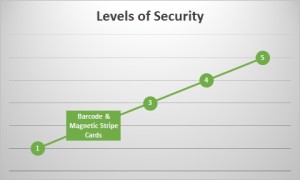Welcome to the second installment in our series on Levels of Security! In this series we are investigating how different ID solutions fit different security needs. As we advise organizations on appropriate badge solutions, we find their needs fall into one of five levels of security. We’ve categorized these by the appropriate solutions: printed PVC cards, barcode and magnetic stripe cards, proximity devices, contact and contactless RFID cards, and biometric authentication.
 Facilities in need of a low-moderate security solution may find that ID cards printed with a bar-code, or with an encoded magnetic stripe, fill their needs. Like the previous level’s solution, these options are still relatively easy to implement and low cost. Facilities that do not require this level of security should refer to the first post in this series: Printed PVC Cards.
Facilities in need of a low-moderate security solution may find that ID cards printed with a bar-code, or with an encoded magnetic stripe, fill their needs. Like the previous level’s solution, these options are still relatively easy to implement and low cost. Facilities that do not require this level of security should refer to the first post in this series: Printed PVC Cards.
Often our clients can meet other needs by making enhancements to their regular ID cards. Some commonly available technologies allow for many uses of these enhanced cards.
- Restaurants and factories, for example, often use time-clock applications. Employees clock in and out by “swiping” card through a reader connected to the payroll system.
- Many schools, colleges and universities have moved to a “one-card” system. This system allows students to obtain meals in cafeterias, access a library, or make purchases by presenting an authorized card.
- Medical service providers’ EHR (electronic health-record) systems often require dual-factor authentication to log in. By equipping system computers with readers for barcode and magnetic stripe cards and appropriate access control software, the employee’s ID card can double as the required second-factor authority.
Barcode Cards
The barcode category includes traditional “1D” bar-codes, “2D” bar-codes, or QR codes. These codes created by selecting a font that transforms an alphanumeric code into a lined or pixelated image. These images are printed onto the card and can be scanned by specialized readers or by smartphone applications. This solution requires a database of some kind that associates the unique graphical code with the pertinent information. A significant limitation here is that barcodes can be photocopied. This can result in unauthorized access if secondary security measures are not put in place.
Magnetic Stripe Cards
 The magnetic stripe card can store a very limited amount of information, such as an account, employee, or student ID number, dollar amount (or other financial balance), & other encoded information. These early versions of modern smart cards are less secure than newer options due to technological advances. The technology used in them makes these a slightly higher-cost option than “plain” PVC cards. In addition, they require specialized readers and a computer program to interpret and act on the stored data.
The magnetic stripe card can store a very limited amount of information, such as an account, employee, or student ID number, dollar amount (or other financial balance), & other encoded information. These early versions of modern smart cards are less secure than newer options due to technological advances. The technology used in them makes these a slightly higher-cost option than “plain” PVC cards. In addition, they require specialized readers and a computer program to interpret and act on the stored data.
Customers who print larger quantities of cards or who would like to be able to issue cards immediately may find that an investment in a printer and supplies is beneficial. For small organizations or those who do not want to maintain cards themselves, our service bureau is able to print cards on demand for a reasonable fee.
Barcode and magnetic stripe cards are excellent solutions for organizations with modest functional needs and low to moderate security requirements. Both options provide a way for customers or patrons to recognize the authority of the person wearing the card. And all ID badge solutions add the benefit of a sense of visual cohesion in any work, school, or healthcare environment.

This is definitely interesting. I think that bar codes are definitely the way to go. Thanks for sharing!